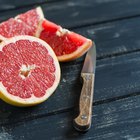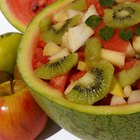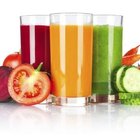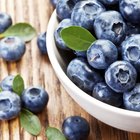
HandmadePictures/iStock/Getty Images
Whether you buy them at the grocery store or pick them yourself, you don’t have much time to enjoy fresh blackberries. The so-called bramble fruit owes its short shelf-life to its design -- a single berry is actually made up of many seed-containing fruits arranged around a fleshy core and held together by minuscule hairs. While this aggregate structure makes blackberries somewhat delicate, it’s also what makes them high in fiber.
Fiber Content
Blackberries are more than an excellent source of fiber, they’re one of the most fiber-rich fruits available. They also pack more fiber per calorie than many other high-fiber foods – a 1-cup serving of fresh blackberries provides about 60 calories and 7.6 grams of fiber, or 30 percent of the recommended daily value, according to the U.S. Department of Agriculture. Close to 80 percent of the fruit’s fiber -- or right around 6 grams per serving, according to Jackson GI Medical -- comes from insoluble fiber. The nearly 1.5 grams of soluble fiber in a serving of blackberries includes a substantial amount of pectin.
Direct Benefits
Eating blackberries promotes digestive function, bowel regularity, normal cholesterol levels and a healthy body weight. Insoluble fiber helps you feel fuller faster by absorbing water and taking up space in your stomach, while soluble fiber helps you feel fuller longer by slowing the rate at which digested food leaves your stomach. Once this digested material reaches your intestinal tract, insoluble fiber helps sweep it through and soluble fiber helps prevent simple sugars from entering your bloodstream too quickly. Pectin, the main soluble fiber in blackberries, is particularly effective at reducing high cholesterol levels. After pectin binds to cholesterol, insoluble fiber helps your body to excrete it.
Intake Advice
You’ve probably heard the rule-of-thumb recommendation for dietary fiber -- most people should aim to consume 25 to 30 grams a day. Specific dietary guidelines advise young men and women to get at least 38 grams and 25 grams of fiber a day, respectively. Because fiber recommendations are based on caloric intake, older adults usually require less fiber -- most men and women past the age of 50 need about 30 grams and 21 grams a day, respectively. Getting enough fiber -- from natural food sources, not supplements -- is thought to protect against bowel disorders, heart disease and diabetes, according to the Harvard School of Public Health.
Considerations
When you eat blackberries to increase your fiber intake, you’ll also boost your intake of several important nutrients -- a 1-cup serving delivers 50 percent and 36 percent of the daily values for vitamins C and K, respectively, and close to 10 percent each of the daily values for folate, magnesium and potassium. Opting for raspberries over blackberries gets you an extra half a gram of fiber per serving for about the same number of calories. Raspberries are often more widely available than blackberries, but both are in season at roughly the same time. Fresh blackberries are harvested throughout the United States from May to September, peaking for a short amount of time in June and July.
Related Articles

What Are the Benefits of Grapefruit for ...

Kiwis vs. Oranges

Nutrition Information on Blueberries

Orange Juice & Fiber
The Best Fruits for Breakfast

Nutritional Value of a D'Anjou Pear

What Fruit Has the Most Fiber?

Nutrition Drinks for Diabetics

How Much Whole Grain Should You Eat a ...

The Carbohydrates in Blueberries

How to Freeze Dewberries
Is There a Loss of Nutritional Value in ...

Are Strawberry Seeds & Flax Seeds ...

Foods That Keep You Awake During the Day

How to Make Natural Pectin From Lemons

Foods High in Fiber & Calcium

Information About the Orange Fruit

Why Are Date Fruits a Superfood?
Calories in Candied Walnuts

How to Thicken Raspberry Jam With ...
References
- Harvard School of Public Health: Fiber: Start Roughing It!
- Wellness Foods A to Z: An Indispensable Guide for Health-Conscious Food Lovers; Sheldon Margen, M.D.
- Field Guide to Produce: How to Identify, Select and Prepare Virtually Every Fruit and Vegetable at the Market; Aliza Green
Writer Bio
Based just outside Chicago, Meg Campbell has worked in the fitness industry since 1997. She’s been writing health-related articles since 2010, focusing primarily on diet and nutrition. Campbell divides her time between her hometown and Buenos Aires, Argentina.
Photo Credits
HandmadePictures/iStock/Getty Images